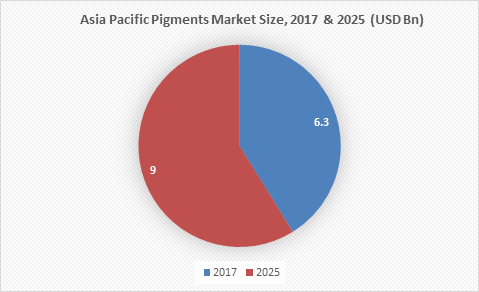According to the Graphical Research new growth forecast report titled “Asia Pacific Pigments Market By Product (Inorganic [Titanium Dioxide, Iron Oxide, Cadmium Pigments, Carbon Black, Chromium Oxide], Organic [Azo, Phthalocyanine, Quinacridone], Specialty [Classic Organic, Metallic, High Performance Organic, Light Interference, Complex Inorganic, Fluorescent, Luminescent, Thermochromic]), By Application (Paints & Coatings, Printing Inks, Plastics, Construction Materials), Industry Analysis Report, Regional Outlook (China, India, Japan, Australia, Malaysia, Indonesia) Estimated to Surpass USD 9 billion by 2025.

Rising construction activities in the region will be the chief factor propelling the growth of Asia Pacific pigments market. In 2013, China accounted for more than half of the total construction spending in the region, followed by Japan and India. Over the last decade, the region has witnessed tremendous development in multiple industries such as manufacturing, automotive, etc., which has augmented the demand for infrastructure development. It has been backed up by public & private investments, favorable norms and initiatives by the government, rising disposable income, etc. Pigments are widely used in paints & coatings sector and growth in construction sector will propel the product demand in coming years. Growth of product market might be negatively influenced by strict government regulations and volatile prices of raw materials.
Among the product segments in the Asia Pacific pigments market, inorganic category is likely to have highest share in terms of volume throughout the study period. Properties like durability, high gloss and anti-corrosion characteristics associated with this product category has resulted in wide range of applications in paints & coatings sector. Moreover, rising demand for industrial and decorative paints will also augment the growth of this product category. Specialty pigments is likely to have high growth rate throughout the study period. This product category includes classic organic, high performance organic, metallic, fluorescent, complex inorganic, thermochromic and luminescent. It possess some superior characteristics that are irreplaceable by both inorganic and organic alternatives.
Paints & coatings application category is likely to have more than 35% market share throughout the study period. This can be ascribed to the wide usage of pigments in this application category for imparting colors. Construction material category is likely to have considerable market share. The product is also widely used in colored roofing for safety passages, wood construction, metal panels, cooler tiles colored shingles, and asphalt. Growth of these application categories will be primarily augmented by rapid development in the regional automotive and construction sector.
Key Asia Pacific pigments market participants includes Lanxess AG, Merck Group, Clariant AG, BASF SE, Tronox Inc, Pidilite Industries Limited, DIC Corporation, Huntsman International LLC, etc. Merger & acquisition is one of the common strategies adopted by many players in the market to strengthen their position in the market.
Asia Pacific pigments market research report includes in-depth coverage of the industry with estimates & forecast in terms of revenue in USD Million from 2014 to 2025, for the following segments:
Asia Pacific Pigments Market Share, By Product
- Inorganic
- Paints & coatings
- Printing inks
- Plastics
- Construction materials
- Others
- Organic
- Paints & coatings
- Printing inks
- Plastics
- Construction materials
- Others
- Specialty
- Paints & coatings
- Printing inks
- Plastics
- Construction materials
- Others
Asia Pacific Pigments Market Size, By Application
- Paints & coatings
- Printing inks
- Plastics
- Construction materials
- Others
The above information is provided on country basis for the following:
- China
- India
- Japan
- Australia
- Indonesia
- Malaysia


